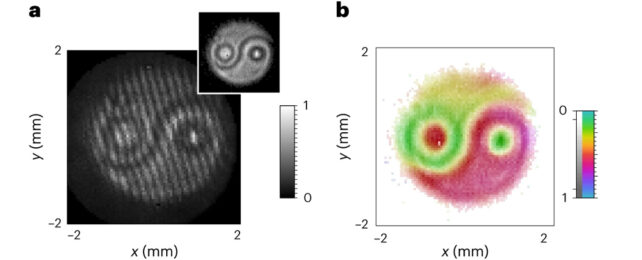Never let it be said that scientists don't have an eye for the sublime.
Encoding and deciphering a Chinese symbol for duality and harmony into the quantum states of two entangled photons, physicists recently demonstrated the superior efficiency of a new analytical technique.
Researchers from the Sapienza University of Rome and the University of Ottawa in Canada used a method similar to a popular holographic technique to quickly and reliably measure information of a particle's position.
By improving on existing methods for capturing critical details on various states in entangled particles, the team hopes to provide engineers with new computing and imaging tools that form the basis of quantum technologies.
Individual photons, like any particle, are best described as a slowly evolving range of possibilities before a measurement bestows hard, factual numbers on them. Polarization, spin, momentum, even their position, are as unsettled as a coin tumbling through the air until a metaphorical hand slaps it into a single state.
If two photons share a history of some kind – like two coins plucked from the same purse – slapping one is as good as stopping the other mid-flight. Entangled as they are, knowing something about one will give you a measure of the other as if it too were slapped into place.
The fundamentals of this game-of-chance form the very basis of quantum computers. Numerous entangled particles called qubits can have one of their states read in ways that will rapidly answer specially formulated mathematical questions.
Yet why use just one state when particles have so many undecided characteristics to choose from, turning simple 2D qubits into 'multi-dimensional' qudits?
To build a more complex picture of a particle, physicists can take a series of measures, just as multiple X-rays are used to build a 3D picture of a body in computerized tomography.
One major problem with adapting quantum tomography to capture numerous dimensions of a particle is the work required. As the number of states being read grows, measurements skyrocket, costing time and dramatically increasing the risk of errors.
Biphoton digital holography could change that. Just as conventional holograms allow us to retrieve 3D information from a 2D surface, it's possible to use the way waves interfere with one another to quickly and precisely infer additional dimensions from just a few details carried between a pair of photons.
Physicists already use the interference of entangled particles to map hidden objects in what's known as ghost imaging. Knowing just enough about the positioning of one photon sent down a single pathway, it's possible to learn the secrets of its partner's journey down a second passage by overlapping their waves.
Applying tricks of holography, the researchers were able to read positional information in the interference of two separated light waves, recovering enough information to recreate a yin-and-yang symbol programmed into the photon-generating apparatus.
As simple as the yin-and-yang looks, this single static image represents a significant leap in measuring numerous quantum states in a short time.
"This method is exponentially faster than previous techniques, requiring only minutes or seconds instead of days," says University of Ottawa physicist Alessio D'Errico.
"Importantly, the detection time is not influenced by the system's complexity – a solution to the long-standing scalability challenge in projective tomography."
This research was published in Nature Photonics.
